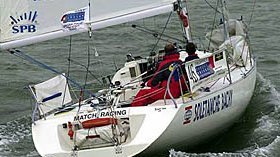Jules Verne Trophy
Orange slowed in the Da Cuhna high
mercredi 17 avril 2002 –
"It’s a bit so-so today, we’re crossing the high". Bruno Peyron’s voice was calm, curiously, because at the end of a fantastic transpacific sprint extended into the heart of the South Atlantic, Orange’s men are facing a new meteorology school case study, the complex crossing of a barrier of high pressure, under the direct threat of a very deep low. "The low accelerated last night quicker than the weather models predicted" continued Bruno. "We’ll have a job avoiding its eastern edge and its 45 knot headwinds." On a NE heading, the maxi-catamaran Orange is doing all she can to escape and cross the centre of high pressure and pick up the easterly winds. The entire wardrobe of foresails is being called on ; from hour to hour, even minute to minute, they must carry the right sail for the wind. 1 reef and solent, 1 reef and medium gennaker ? all imaginable combinations of sail are being adapted to the angle and force of the wind. "6 heavy manoeuvres per day since the start, sail changes and reef taking !" admitted Peyron. For lack of wind, Orange is running on muscle power. "It’s no bad thing" said a smiling Yann Eliès, "After 46 days at sea, we’re in top form !" And that little ray of sunshine that is barely filtering through the cirrus is enough to multiply their enthusiasm. "Flat out in the south, one huddles down in the bottom of the hulls" continued Eliès. "It’s good to enjoy the boat for a change, to dry a bit and laze on deck between watches...". Once again, Peyron’s boys are going to have to fork out to see and touch the SE trades. How much ? Aeolus the wind god will be presenting the bill in a day’s time, maybe two ! The Atlantic is a costly place for adventurers : "We crossed the Indian with one weather pattern, albeit a rather lousy one" calculated Peyron, "the Australian Bight and the Pacific with two well established patterns... and only 3 days into the Atlantic and we’re already negotiating our 3rd system !"
Quote / unquote...
Bruno Peyron : "The Pacific was ripe for attacking. The Atlantic along the Brazilian coast demands us to lift off the gas head to wind and seaway. After 21,000 nm of racing, we have no desire to be stopped by some breakage or other. We’re lifting off, even it means taking it on the chin, and going after the trades without breaking. That’s the objective !"
Yann Eliès : "We’re beginning to take it easier with the improving climate. The boat and the clothes are drying out. We’re in excellent shape, the meals are perfectly balanced and we have no skin complaints to complain about, which for sailors who sail for extended periods in the damp on these boats is quite remarkable... I’m appreciating and learning a lot alongside Bruno. Last year on Team Adventure, everything was sacrificed for speed. On Orange, management of the men and the gear is the most important thing with an eye on long term performance..."
Denis van den Brink / Mer & Média / Translation David Palmer / SeaSpeak
Dans la même rubrique
Jules Verne Trophy : Orange goes East…
East - West Atlantic record : Maiden II is 240 nm late from Club Med

Jules Verne Trophy : Orange credited with an average speed of 23.05
South Atlantic Record : This is why we do it ! for Maiden
 Sea, Sail & Surf news
Sea, Sail & Surf news










